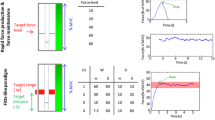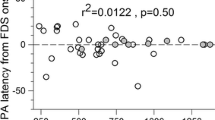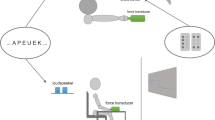Abstract
Anticipatory synergy adjustment (ASA) is a feed-forward control mechanism that describes a continuous decrease in the stability of the current motor state beginning about 150 ms prior to a state transition. Recently, we described an associated phenomenon in which the system stability was reduced solely in response to a cue that generates an expectation of a state change, independent of whether the state change actually occurs. Both phenomena are of the same kind (stability reduction), but evoked by distinct antecedent conditions. Since, logically, cuing for movement must occur before the initiation of that movement, we named this new phenomenon ‘Stage-1 ASA’ and rechristened the well-established version ‘Stage-2 ASA’. Here, we used a four-finger, isometric force production task to explore (1) the effect of healthy aging on Stage-1 ASA, and (2) if Stage-1 ASA resulted in a more rapid state change. Young and older adult participants produced 10% of their maximal force when they did not expect to produce any change in the force, and when they expected to change their force in an unknown direction and at an unknown time. In the latter condition, the 10% constant-force phase was followed by a choice reaction time task, in which the participants rapidly changed their force to follow a moving target presented on a computer monitor. Both young and older adults displayed equivalent amount of Stage-1 ASA. This was driven by a 42% reduction in finger-force variability in young adults. In contrast, it was driven by a 38% increase in finger-force variability in older adults. We speculate that the reduction in finger force variability assists the young adults in rapid state changes via two mechanisms: (1) the finger forces occupy a restricted set of states that are optimal for quick state transitions, and (2) lower variability during steady state translates into lower self-motion during state transition. Self-motion is the covariation between finger forces that fails to change the total force. The older adults are unable to adopt this strategy, and the increase in finger-force variability arises from (1) the adoption of an alternative strategy of destabilizing the attractor associated with the current state to facilitate state transitions and (2) the inability to coordinate multiple finger forces. Finally, older adults displayed longer reaction times than young adults, but a clear relation between Stage-1 ASA and consequent behavioral benefit in terms of reduced reaction time remained elusive.








Similar content being viewed by others
References
Ambike S, Mattos D, Zatsiorsky VM, Latash ML (2016a) Synergies in the space of control variables within the equilibrium-point hypothesis. Neuroscience 315:150–161. https://doi.org/10.1016/j.neuroscience.2015.12.012
Ambike S, Mattos D, Zatsiorsky VM, Latash ML (2016b) Unsteady steady-states: central causes of unintentional force drift. Exp Brain Res 234:3597–3611. https://doi.org/10.1007/s00221-016-4757-7
Arpinar-Avsar P, Park J, Zatsiorsky VM, Latash ML (2013) Effects of muscle vibration on multi-finger interaction and coordination. Exp Brain Res 229:103–111. https://doi.org/10.1007/s00221-013-3597-y
Bernstein NA (1996) On dexterity and its development. Lawrence Erlbaum, Mahwah
Birren JE (1974) Translations in gerontology—lab to life—psychophysiology and speed of response. Am Psychol 29:808–815. https://doi.org/10.1037/h0037433
Brunia CH (1993) Waiting in readiness: gating in attention and motor preparation. Psychophysiology 30:327–339
Brunia CHM, Geert JMvB, Bocker KEB (2012) Negative slow waves as indices of anticipation: the bereitschaftspotential, the contingent negative variation, and the stimulus-preceding negativity. In: Kappenman ES, Luck SJ (eds) The Oxford handbook of event-related potential components. Oxford University Press, Oxford, pp 189–207
Christou EA, Shinohara M, Enoka RM (2003) Fluctuations in acceleration during voluntary contractions lead to greater impairment of movement accuracy in old adults. J Appl Physiol 95:373–384. https://doi.org/10.1152/japplphysiol.00060.2003
Churchland MM, Yu BM, Ryu SI, Santhanam G, Shenoy KV (2006) Neural variability in premotor cortex provides a signature of motor preparation. J Neurosci 26:3697–3712. https://doi.org/10.1523/JNEUROSCI.3762-05.2006
Clark BC, Manini TM (2008) Sarcopenia =/= dynapenia. J Gerontol A Biol Sci Med Sci 63:829–834
Cole KJ (1991) Grasp force control in older adults. J Mot Behav 23:251–258. https://doi.org/10.1080/00222895.1991.9942036
Cole KJ (2006) Age-related directional bias of fingertip force. Exp Brain Res 175:285–291. https://doi.org/10.1007/s00221-006-0553-0
Cole KJ, Rotella DL (2001) Old age affects fingertip forces when restraining an unpredictably loaded object. Exp Brain Res 136:535–542. https://doi.org/10.1007/s002210000613
Cole KJ, Rotella DL, Harper JG (1999) Mechanisms for age-related changes of fingertip forces during precision gripping and lifting in adults. J Neurosci 19:3238–3247
Cole KJ, Cook KM, Hynes SM, Darling WG (2010) Slowing of dexterous manipulation in old age: force and kinematic findings from the ‘nut-and-rod’ task. Exp Brain Res 201:239–247. https://doi.org/10.1007/s00221-009-2030-z
Collins DR, Park H, Turvey MT (1998) Relative coordination reconsidered: a stochastic account. Mot Control 2:228–240
Dayanidhi S, Valero-Cuevas FJ (2014) Dexterous manipulation is poorer at older ages and is dissociated from decline of hand strength. J Gerontol A Biol Sci Med Sci 69:1139–1145. https://doi.org/10.1093/gerona/glu025
de Freitas SM, Scholz JP, Stehman AJ (2007) Effect of motor planning on use of motor abundance. Neurosci Lett 417:66–71. https://doi.org/10.1016/j.neulet.2007.02.037
de Bruin N, Bryant DC, MacLean JN, Gonzalez CL (2016) Assessing visuospatial abilities in healthy aging: a novel visuomotor task. Front Aging Neurosci 8:7. https://doi.org/10.3389/fnagi.2016.00007
Desrosiers J, Hebert R, Bravo G, Rochette A (1999) Age-related changes in upper extremity performance of elderly people: a longitudinal study. Exp Gerontol 34:393–405
Dingwell JB, Marin LC (2006) Kinematic variability and local dynamic stability of upper body motions when walking at different speeds. J Biomech 39:444–452. https://doi.org/10.1016/j.jbiomech.2004.12.014
Enoka RM (2015) Neuromechanics of human movement. Human Kinetics, Champaign
Enoka RM, Christou EA, Hunter SK, Kornatz KW, Semmler JG, Taylor AM, Tracy BL (2003) Mechanisms that contribute to differences in motor performance between young and old adults. J Electromyogr Kinesiol 13:1–12
Freitas SMSF, Scholz JP (2009) Does hand dominance affect the use of motor abundance when reaching to uncertain targets? Hum Mov Sci 28:169–190. https://doi.org/10.1016/j.humov.2009.01.003
Gabell A, Nayak US (1984) The effect of age on variability in gait. J Gerontol 39:662–666
Galganski ME, Fuglevand AJ, Enoka RM (1993) Reduced control of motor output in a human hand muscle of elderly subjects during submaximal contractions. J Neurophysiol 69:2108–2115. https://doi.org/10.1152/jn.1993.69.6.2108
Goodman D, Kelso JA (1980) Are movements prepared in parts? Not under compatible (naturalized) conditions. J Exp Psychol Gen 109:475–495
Goodman SR, Latash ML (2006) Feed-forward control of a redundant motor system. Biol Cybern 95:271–280. https://doi.org/10.1007/s00422-006-0086-4
Hamilton LD, Thomas E, Almuklass AM, Enoka RM (2017) A framework for identifying the adaptations responsible for differences in pegboard times between middle-aged and older adults. Exp Gerontol 97:9–16. https://doi.org/10.1016/j.exger.2017.07.003
Hasan Z (2005) The human motor control system’s response to mechanical perturbation: should it, can it, and does it ensure stability? J Mot Behav 37:484–493. https://doi.org/10.3200/JMBR.37.6.484-493
Hedden T, Gabrieli JDE (2004) Insights into the ageing mind: a view from cognitive neuroscience. Nat Rev Neurosci 5:87–96. https://doi.org/10.1038/nrn1323
Herrmann CS, Pauen M, Min BK, Busch NA, Rieger JW (2008) Analysis of a choice-reaction task yields a new interpretation of Libet’s experiments. Int J Psychophysiol 67:151–157. https://doi.org/10.1016/j.ijpsycho.2007.10.013
Hick WE (1952) On the rate of gain of information. Q J Exp Psychol 4:11–26
Hoff M, Trapp S, Kaminski E, Sehm B, Steele CJ, Villringer A, Ragert P (2015) Switching between hands in a serial reaction time task: a comparison between young and old adults. Front Aging Neurosci. https://doi.org/10.3389/fnagi.2015.00176
Horak FB, Nutt JG, Nashner LM (1992) Postural inflexibility in parkinsonian subjects. J Neurol Sci 111:46–58
Huang HJ, Ahmed AA (2011) Tradeoff between stability and maneuverability during whole-body movements. Plos One. https://doi.org/10.1371/journal.pone.0021815
Hyman R (1953) Stimulus information as a determinant of reaction time. J Exp Psychol 45:188–196
Jahanshahi M, Brown RG, Marsden CD (1992) Simple and choice reaction time and the use of advance information for motor preparation in Parkinson’s disease. Brain 115(Pt 2):539–564
Jo HJ, Mattos D, Lucassen EB, Huang X, Latash ML (2017) Changes in multidigit synergies and their feed-forward adjustments in multiple sclerosis. J Mot Behav 49:218–228. https://doi.org/10.1080/00222895.2016.1169986
Kallman DA, Plato CC, Tobin JD (1990) The role of muscle loss in the age-related decline of grip strength—cross-sectional and longitudinal perspectives. J Gerontol 45:M82–M88. https://doi.org/10.1093/geronj/45.3.M82
Kapur S, Zatsiorsky VM, Latash ML (2010) Age-related changes in the control of finger force vectors. J Appl Physiol 109:1827–1841. https://doi.org/10.1152/japplphysiol.00430.2010
Kelso JAS (1995) Dynamic patterns: the self-organization of brain and behavior. MIT Press, Cambridge
Kelso J, Scholz JP, Schöner G (1986) Nonequilibrium phase transitions in coordinated biological motion: critical fluctuations. Phys Lett A 118:279–284
Kim SW, Shim JK, Zatsiorsky VM, Latash ML (2006) Anticipatory adjustments of multi-finger synergies in preparation for self-triggered perturbations. Exp Brain Res 174:604–612. https://doi.org/10.1007/s00221-006-0505-8
Klous M, Mikulic P, Latash ML (2011) Two aspects of feedforward postural control: anticipatory postural adjustments and anticipatory synergy adjustments. J Neurophysiol 105:2275–2288. https://doi.org/10.1152/jn.00665.2010
Kording KP, Wolpert DM (2004) Bayesian integration in sensorimotor learning. Nature 427:244–247. https://doi.org/10.1038/nature02169
Krishnan V, Aruin AS, Latash ML (2011) Two stages and three components of the postural preparation to action. Exp Brain Res 212:47–63. https://doi.org/10.1007/s00221-011-2694-z
Latash ML (2008) Synergy. Oxford University Press, New York
Latash ML, Huang X (2015) Neural control of movement stability: lessons from studies of neurological patients. Neuroscience 301:39–48. https://doi.org/10.1016/j.neuroscience.2015.05.075
Latash ML, Zatsiorsky VM (2016) Biomechanics and motor control. Defining central concepts. Academic Press, New York
Latash ML, Scholz JP, Schoner G (2002) Motor control strategies revealed in the structure of motor variability. Exerc Sport Sci Rev 30:26–31
Lexell J (1997) Evidence for nervous system degeneration with advancing age. J Nutr 127:1011S–1013S
Lindberg P, Ody C, Feydy A, Maier MA (2009) Precision in isometric precision grip force is reduced in middle-aged adults. Exp Brain Res 193:213–224. https://doi.org/10.1007/s00221-008-1613-4
Marmon AR, Pascoe MA, Schwartz RS, Enoka RM (2011) Associations among strength, steadiness, and hand function across the adult life span. Med Sci Sports Exerc 43:560–567. https://doi.org/10.1249/MSS.0b013e3181f3f3ab
Mattos D, Schoner G, Zatsiorsky VM, Latash ML (2015) Task-specific stability of abundant systems: structure of variance and motor equivalence. Neuroscience 310:600–615. https://doi.org/10.1016/j.neuroscience.2015.09.071
Morgan M, Phillips JG, Bradshaw JL, Mattingley JB, Iansek R, Bradshaw JA (1994) Age-related motor slowness—simply strategic. J Gerontol 49:M133–M139. https://doi.org/10.1093/geronj/49.3.M133
Niemi P, Naatanen R (1981) Foreperiod and simple reaction-time. Psychol Bull 89:133–162. https://doi.org/10.1037//0033-2909.89.1.133
Olafsdottir H, Yoshida N, Zatsiorsky VM, Latash ML (2005) Anticipatory covariation of finger forces during self-paced and reaction time force production. Neurosci Lett 381:92–96. https://doi.org/10.1016/j.neulet.2005.02.003
Olafsdottir H, Yoshida N, Zatsiorsky VM, Latash ML (2007a) Elderly show decreased adjustments of motor synergies in preparation to action. Clin Biomech 22:44–51. https://doi.org/10.1016/j.clinbiomech.2006.08.005
Olafsdottir H, Zhang W, Zatsiorsky VM, Latash ML (2007b) Age-related changes in multifinger synergies in accurate moment of force production tasks. J Appl Physiol 102:1490–1501. https://doi.org/10.1152/japplphysiol.00966.2006
Olafsdottir HB, Kim SW, Zatsiorsky VM, Latash ML (2008) Anticipatory synergy adjustments in preparation to self-triggered perturbations in elderly individuals. J Appl Biomech 24:175–179
Park J, Xu D (2017) Multi-finger interaction and synergies in finger flexion and extension force production. Front Hum Neurosci 11:318. https://doi.org/10.3389/fnhum.2017.00318
Park J, Sun Y, Zatsiorsky VM, Latash ML (2011) Age-related changes in optimality and motor variability: an example of multifinger redundant tasks. Exp Brain Res 212:1–18. https://doi.org/10.1007/s00221-011-2692-1
Park J, Wu YH, Lewis MM, Huang X, Latash ML (2012) Changes in multifinger interaction and coordination in Parkinson’s disease. J Neurophysiol 108:915–924. https://doi.org/10.1152/jn.00043.2012
Piscitelli D, Falaki A, Solnik S, Latash ML (2017) Anticipatory postural adjustments and anticipatory synergy adjustments: preparing to a postural perturbation with predictable and unpredictable direction. Exp Brain Res 235:713–730. https://doi.org/10.1007/s00221-016-4835-x
Prochazka A (1989) Sensorimotor gain control: a basic strategy of motor systems? Prog Neurobiol 33:281–307
Riccio GE (1993) Information in movement variability about quantitative dynamics of posture and orientation. In: Newell KMC, D. (ed) Variability and motor control. Human Kinetics, Champaign, pp 317–357
Riccio GE, Stoffregen TA (1988) Affordances as constraints on the control of stance. Hum Mov Sci 7:265–300
Riley MA, Turvey MT (2002) Variability of determinism in motor behavior. J Mot Behav 34:99–125. https://doi.org/10.1080/00222890209601934
Salthouse TA (1996) The processing-speed theory of adult age differences in cognition. Psychol Rev 103:403–428. https://doi.org/10.1037/0033-295x.103.3.403
Scheirs J, Brunia C (1985) Achilles tendon reflexes and surface EMG activity during anticipation of a significant event and preparation for a voluntary movement. J Mot Behav 17:96–109
Scholz JP, Schoner G (1999) The uncontrolled manifold concept: identifying control variables for a functional task. Exp Brain Res 126:289–306
Seidler RD, Bernard JA, Burutolu TB et al (2010) Motor control and aging: links to age-related brain structural, functional, and biochemical effects. Neurosci Biobehav Rev 34:721–733. https://doi.org/10.1016/j.neubiorev.2009.10.005
Sherrington CS (1906) The integrative action of the nervous system. Yale University Press, New Haven
Shim JK, Lay BS, Zatsiorsky VM, Latash ML (2004) Age-related changes in finger coordination in static prehension tasks. J Appl Physiol 97:213–224. https://doi.org/10.1152/japplphysiol.00045.2004
Shim JK, Olafsdottir H, Zatsiorsky VM, Latash ML (2005) The emergence and disappearance of multi-digit synergies during force-production tasks. Exp Brain Res 164:260–270. https://doi.org/10.1007/s00221-005-2248-3
Shim JK, Park J, Zatsiorsky VM, Latash ML (2006) Adjustments of prehension synergies in response to self-triggered and experimenter-triggered load and torque perturbations. Exp Brain Res 175:641–653. https://doi.org/10.1007/s00221-006-0583-7
Shinohara M, Latash ML, Zatsiorsky VM (2003a) Age effects on force produced by intrinsic and extrinsic hand muscles and finger interaction during MVC tasks. J Appl Physiol 95:1361–1369. https://doi.org/10.1152/japplphysiol.00070.2003
Shinohara M, Li S, Kang N, Zatsiorsky VM, Latash ML (2003b) Effects of age and gender on finger coordination in MVC and submaximal force-matching tasks. J Appl Physiol 94:259–270. https://doi.org/10.1152/japplphysiol.00643.2002
Shinohara M, Scholz JP, Zatsiorsky VM, Latash ML (2004) Finger interaction during accurate multi-finger force production tasks in young and elderly persons. Exp Brain Res 156:282–292. https://doi.org/10.1007/s00221-003-1786-9
Smith CD, Umberger GH, Manning EL et al (1999) Critical decline in fine motor hand movements in human aging. Neurology 53:1458–1461
Stevens JC, Patterson MQ (1995) Dimensions of spatial acuity in the touch sense—changes over the life-span. Somatosens Mot Res 12:29–47. https://doi.org/10.3109/08990229509063140
Temprado JJ, Vieluf S, Sleimen-Malkoun R (2017) Age-related changes in force control under different task contexts. Exp Brain Res 235:231–246. https://doi.org/10.1007/s00221-016-4787-1
Tillman M, Ambike S (2018) Cue-induced changes in the stability of finger force-production tasks revealed by the uncontrolled manifold analysis. J Neurophysiol 119:21–32. https://doi.org/10.1152/jn.00519.2017
Togo S, Imamizu H (2016) Anticipatory synergy adjustments reflect individual performance of feedforward force control. Neurosci Lett 632:192–198. https://doi.org/10.1016/j.neulet.2016.08.032
Vaillancourt DE, Newell KM (2003) Aging and the time and frequency structure of force output variability. J Appl Physiol 94:903–912. https://doi.org/10.1152/japplphysiol.00166.2002
van Emmerik RE, van Wegen EE (2000) On Variability and stability in human movement. J Appl Biomech 16:394–406
Wang Y, Asaka T, Zatsiorsky VM, Latash ML (2006) Muscle synergies during voluntary body sway: combining across-trials and within-a-trial analyses. Exp Brain Res 174:679–693. https://doi.org/10.1007/s00221-006-0513-8
Wilhelm L, Zatsiorsky VM, Latash ML (2013) Equifinality and its violations in a redundant system: multifinger accurate force production. J Neurophysiol 110:1965–1973. https://doi.org/10.1152/jn.00461.2013
Wolpert DM, Landy MS (2012) Motor control is decision-making. Curr Opin Neurobiol 22:996–1003. https://doi.org/10.1016/j.conb.2012.05.003
Wu MN, Matsubara JH, Gordon KE (2015) General and specific strategies used to facilitate locomotor Maneuvers. Plos One 10:e0132707. https://doi.org/10.1371/journal.pone.0132707
Yancosek KE, Howell D (2009) A narrative review of dexterity assessments. J Hand Ther 22:258–269. https://doi.org/10.1016/j.jht.2008.11.004
Zatsiorsky VM, Li ZM, Latash ML (2000) Enslaving effects in multi-finger force production. Exp Brain Res 131:187–195
Zhou T, Wu YH, Bartsch A, Cuadra C, Zatsiorsky VM, Latash ML (2013) Anticipatory synergy adjustments: preparing a quick action in an unknown direction. Exp Brain Res 226:565–573. https://doi.org/10.1007/s00221-013-3469-5
Author information
Authors and Affiliations
Corresponding author
Rights and permissions
About this article
Cite this article
Tillman, M., Ambike, S. Expectation of movement generates contrasting changes in multifinger synergies in young and older adults. Exp Brain Res 236, 2765–2780 (2018). https://doi.org/10.1007/s00221-018-5333-0
Received:
Accepted:
Published:
Issue Date:
DOI: https://doi.org/10.1007/s00221-018-5333-0




